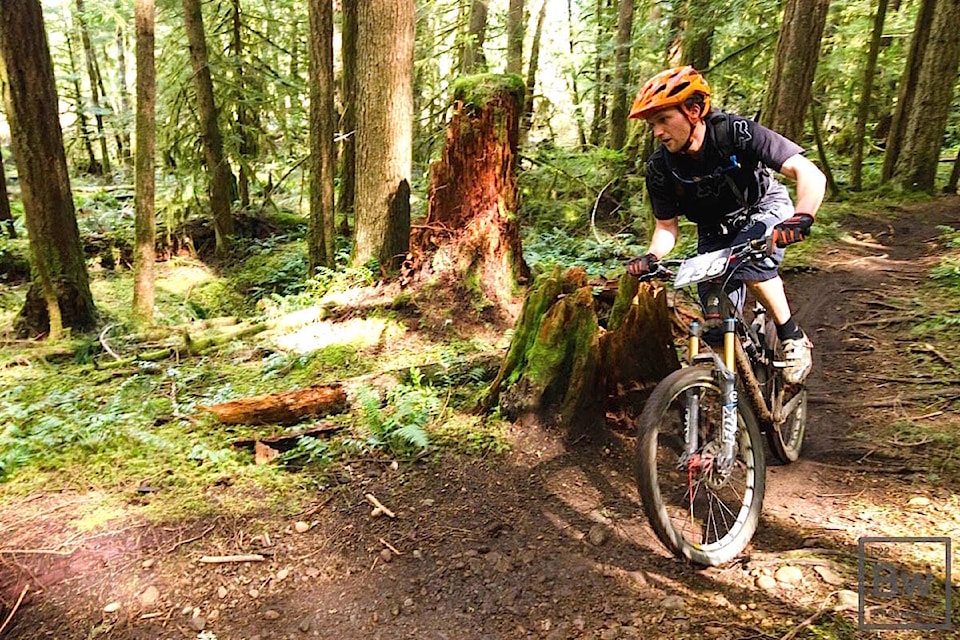Nestled within the heart of Vancouver Island’s Comox Valley lies a haven for adrenaline seekers.
With 200 kilometres of managed trails, spanning over 6,500 acres, the hills surrounding Cumberland have become a mecca for mountain biking in North America over the years.
Each of the 200-plus trails in this natural playground carries a name that hides a rich history, filled with camaraderie, laughter and stories.
Dougal Browne, executive director of the United Riders of Cumberland (UROC), who has built more than 40 mountain biking trails in his lifetime, explains that most of the time, those who spearhead the trail building get the honour of baptizing the latter.
“The choice behind a trail name is often a fun, light-hearted and not-so-serious aspect of trail building,” Browne says.
READ MORE: Why mountain biking should be your new travel activity — plus tips for beginners
Builders typically draw inspiration from memorable events, humorous anecdotes, historical tales, or any significant experiences they encountered during their journey of creating a new path.
One of Browne’s favourite trail names is Two and a Juice.
“A long time ago, there used to be a mine (up in the mountains) and mine workers would come out for their lunch break when they were allowed to stop,” Browne says. “There was a rather enterprising man who would go up to that mine head with portable lunch packs containing sandwiches and juices. (It’s) said that you would hear the workers shout their order through the forest saying: ‘Two and a juice for me!’ ”
However, riders should not be swayed by the whimsical names of the trails when choosing their next path.
“Probably the steepest trail in Cumberland is called Cupcake,” Browne notes. “The main trail builder decided to name it this way he had some leftover cupcakes from his baby shower and he took out the trails (and shared them) with the others.”
READ MORE: Shake off the year’s stress with an adrenaline-filled weekend in the Comox Valley
Some other bike paths bear the weight of an interesting local lore.
Bucket of Blood pays homage to a now-closed rowdy Cumberland bar that was the theatre of numerous booze-fuelled feuds in its heyday.
“Going down to that bar on a Friday night was considered a night with a bucket of blood because you would often end up in a fight,” Browne says.
Perhaps one of the most famous trails in the network, Space Nugget, has a long history dear to the community.
“Before (Space Nugget) even existed, there was a trail called Black Hole (named after some riders) found a huge mine shaft hole next to a path which was covered by logs,” Browne says. “When they threw a rock in it, it echoed down the hole, (hence the name). When Space Nugget was being built, people said that it was in this ‘really lovely nugget of a forest.’ They nicknamed it Space Nugget in line with the space theme of Black Hole.”
In the early 2000s, the Cumberland Community Forest Society successfully raised enough funds to purchase the land through which the trail runs, ensuring its protection from being logged. This effort was part of a major campaign known as Save Space Nugget, which was featured in a 40-minute documentary.
B.C. boasts a long mountain biking history
Mountain biking in B.C. has its origins in North Vancouver in the late 1980s.
Influenced by their experiences riding the trails in the Mainland metropolis, a group from Cumberland returned home in the early ’90s, filled with enthusiasm, and set out to create a community of their own.
What started as a small initiative blossomed into a trail network with 15 mapped trails by the early 2000s.
Today, Cumberland offers one of the largest trail networks in North America, receiving more than 220,000 visits last year.
Yet, the success of Cumberland’s mountain biking culture is in large part due to a group of devoted community actors.
Volunteers and grassroots organizations engaged in discussions with logging companies that own the surrounding forest, namely Mosaic Forest Management and Manulife Investment Management, as well as the Village of Cumberland. Together, they spearheaded a benchmark land access agreement – the first of its kind in Canada.
Administered by UROC, this trailblazing partnership has set the standard for collaboration between private landowners and recreational users, thanks to the effectiveness of community-driven initiatives.
“The reason that Cumberland is so prominently on the map is that it’s got all of these wonderful things attached to it,” Browne says. “The network is huge, it’s right beside the village, it’s organized, it’s well maintained, it’s grassroots, it’s organic. Everybody’s happy to go into that forest and come out of there happy. It’s just a positive space in the world and that’s hard to come by these days.”
For more information about mountain biking in Cumberland or to know more about upcoming events, visit UROC’s website via unitedridersofcumberland.com, follow the group on Instagram, or join their Facebook page.
Plan your adventures throughout the West Coast at westcoasttraveller.com and follow us on Facebook and Instagram @thewestcoasttraveller. And for the top West Coast Travel stories of the week delivered right to your inbox, sign up for our weekly Armchair Traveller newsletter!
